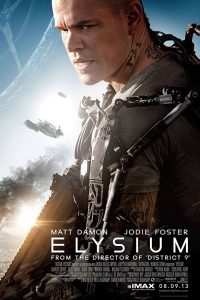The Fifty Years Later Affair: A Review of The Man from U.N.C.L.E.
 by Gary Westfahl
by Gary Westfahl
If anyone is wondering why a science fiction film critic would be interested in reviewing a film version of the television series The Man from U.N.C.L.E. (1964-1968), it is important to recognize that when the series debuted in 1964, it represented one of the few opportunities for viewers to watch science fiction of any kind. The Outer Limits (1963-1965) was in the process of being killed off by the ABC network, which had exiled the series to early Saturday evening, and except for the near-future aquatic adventurers of Voyage to the Bottom of the Sea (1964-1968), the only other alternatives were inane comedies – My Favorite Martian (1963-1966) and My Living Doll (1964-1965) – and kids’ stuff – the animated series Jonny Quest (1964-1965). In a milieu of mundanity, even the mildly futuristic technology wielded by spies Napoleon Solo and Illya Kuryakin could be greatly appreciated.
Surely, the producers of this film were not primarily focused on the aging demographic of individuals who remember watching The Man from U.N.C.L.E. half a century ago, yet even as they strived to make its scenario appealing to millennials, they must have felt an obligation to respect the original series’ spirit and character; to some extent they succeeded, and to some extent they failed. Instead of transplanting its characters into the present, the film retains the mid-1960s setting of the series; the style and yellow color of the subtitles’ lettering resemble that of the series; the film further recalls the 1960s by actually beginning with several minutes of credits, in contrast to the current practice of withholding them all until the end; Henry Cavill and Armie Hammer are acceptable replacements for Robert Vaughn and David McCallum, and Hugh Grant is surprisingly good as Waverly; and its story line would have fit perfectly into the series: an ex-Nazi scientist, Udo Teller (Christian Berkel), has developed a superior way to produce uranium for nuclear weapons, and a sinister businesswoman plans to employ his findings to sell bombs on the black market – unless she can be stopped by Solo and Kuryakin. The film even replicates, surprisingly, another characteristic of the series – a virtually all-white cast – which one would not expect today, though this might appear justifiable in a film set entirely in the Berlin and Italy of the 1960s.
Yet the film is also very different from the original series in several ways. The basic goal of the screenplay’s four authors was to offer something that the series had never provided: an origin story, explaining how secret agents Solo and Kuryakin, and their boss Waverly, first got together and became part of something called the United Network Command for Law and Enforcement. Thus, one gets a glimpse of the functioning organization of the series only in a few documents shown during the closing credits, and fans must wait for the film’s sequel (if it is made) to see Cavill’s Solo and Hammer’s Kuryakin walk into the tailor shop that conceals U.N.C.L.E.’s high-tech headquarters and plan their next mission. In keeping with contemporary sensibilities, one supposes, the previously flawless Solo and Kuryakin are given a few skeletons in their closets: Solo is now a former art thief who agreed to work for the CIA to avoid a prison sentence, and a troubled upbringing brought Kuryakin severe psychological problems which he eventually overcame to become an admired KGB agent, though he still can display an explosive temper. As another bow to modernity, the end credits indicate that, in any future films, Solo and Kuryakin will be joined by the new female agent who was introduced in this film, a car mechanic turned spy named Gaby Teller (Alicia Vikander). And, needless to say, none of the film’s secret agents employ communicators disguised as packs of cigarettes.
More significantly, the film ignores one key priority of the series, which was to involve ordinary people in U.N.C.L.E.’s business: on the trail of some spy, Solo would regularly stumble into a hapless housewife or nerdy accountant and find himself obliged to rely upon their assistance. But this film’s only contact with the working class comes in its opening scene, when Solo meets Gaby while she is repairing a car; otherwise, Solo and Kuryakin exclusively experience the lifestyles of the rich and famous, as they stay in fancy hotels and attend lavish parties hosted by their fabulously wealthy opponent, Victoria Vinciguerra (Elizabeth Debicki). It is noteworthy that both Solo and Kuryakin, unlike their television counterparts, present themselves as experts on men’s and women’s fashion, as if to emphasize that they are accustomed to traveling only in very fashionable company.
There is also a problem with the overall tone of the film, which is hard to articulate but readily discernible to viewers who liked the series but find themselves disliking the film. The series consistently provided what might be termed light-hearted adventures: characters took their work seriously, and responded with appropriate concern and energy to every threat, but they could also appreciate the humor in some precarious moments and find ways to enjoy themselves in some unlikely situations. The film visibly endeavors to have the same ambience, but it doesn’t. The screenplay instructs actors to appear casual and relaxed at certain times, but with the exception of Grant’s Waverly (who only appears in a few scenes), Cavill and Hammer invariably project only tension and anxiety. The screenplay gives the actors jokes to deliver, but they usually intone them as if performing an onerous chore. All of the film’s attempts at humor, then, unsurprisingly fall flat, which is why it is so odd to see that the Internet Movie Database describes one of its genres as “comedy”; for the film never made me laugh, and I don’t recall anybody else in the theatre ever laughing.
The issue comes to the forefront in the film’s most bizarre scene: after Solo falls out of a boat in which he and Kuryakin have been fleeing from armed assailants in bigger boats, he reaches shore, gets into a truck, finds a bottle of wine and a sandwich sitting on the passenger seat, and proceeds to drink some wine and eat the sandwich as he calmly watches Kuryakin struggling to stay alive as his beleaguered boat catches on fire. Noting that Kuryakin has now fallen into the water and is undoubtedly drowning, Solo then puts down his sandwich with visible reluctance and sets out to rescue him by driving the truck onto an enemy boat and diving into the water to grab Kuryakin and pull him to the surface.
What, one wonders, was the point of this scene? One might interpret it as a modern version of the old Zen fable in which a man, clinging to a branch on a cliff and about to fall to the death, plucks a strawberry, eats it, and proclaims, “The strawberry is sweet.” Yes, even while being pursued by machine-gun-wielding fanatics, a man should always pause to appreciate some fine wine and hearty food. But Cavill’s Solo doesn’t seem to be enjoying his meal. Perhaps this is supposed to represent a key turning point in the film, as Solo ponders whether he should really rush to the rescue of an avowed enemy turned reluctant ally and realizes that he is really a friend who merits his assistance. Perhaps we are supposed to conclude that, in contrast to the good-hearted Kuryakin, Solo is actually something of a cad, coldly waiting until the last possible moment to save his dying partner. In any event, one has to imagine the filmmakers believed that the incongruity of Solo’s actions would somehow be amusing, but they aren’t; they are simply senseless and disturbing.
We are possibly observing an unintended effect of the high-stakes wagers that Hollywood is now accustomed to making. Back in the 1960s, it was easy for Vaughn and McCallum to approach their work in a laid-back manner: if their series succeeded, that would be great, but if it failed, they could readily support themselves by means of guest appearances in other series while realistically hoping for another opportunity. Today, it seems, every film represents a huge all-or-nothing gamble, and it may be inevitable that an air of nervousness permeates every production. Thus, if told that he needed to stop acting so uptight, Hammer might respond, “What? I’m making a film that probably represents my last chance to become a big star, with millions and millions of dollars on the line, and you’re telling me to relax?” In sum, filming casually humorous adventures may now be possible only for independent filmmakers with low budgets and little to lose.
I said before that The Man from U.N.C.L.E. is a science fiction film, but it belongs to a special category that critics would now describe as the “technothriller.” Such works differ from typical science fiction in at least three respects: they take place in the present or the very near future; they foreground only modest improvements in today’s technology; and while science fiction explores how new inventions and discoveries might change the world, the machinery of the technothriller is invariably dedicated to preserving the status quo at all costs. Since the innovations envisioned in technothrillers often seem quite revolutionary in their probable impact – here, a method for processing uranium that would make it possible for almost anyone to build a nuclear bomb – one might think that they would necessarily disturb society, but the technothriller addresses the issue by borrowing a common figure in popular culture, the mad scientist. Unlike actual scientists, mad scientists work entirely in isolation; they achieve amazing breakthroughs all by themselves, working in their basements; they are the only people in the entire world who possess, or could possibly possess, the information needed to create their new invention; and as long as one contrives to kill the scientists, and burns their notes, their potentially world-changing innovations will forever vanish from the scene. It is not really a “spoiler” to note that the story of this film’s mad scientist, Dr. Teller, precisely follows this formula; for the tragic fate of such characters and their work is as preordained as that of the characters in the original Star Trek (1966-1969) who wore red shirts. And unrealistically portraying scientists as lonely geniuses doomed to failure is reassuring to audiences who like the status quo and would hate to imagine scientific progress upsetting their apple carts.
Watching The Man from U.N.C.L.E. helped me recognize another aspect of the technothriller which in a way represents a welcome departure from most science fiction, at least the science fiction we are now accustomed to seeing in theatres. It is true that the stories always have easily identifiable heroes and villains, in the standard manner of melodrama, and manifestly evil plans that must be thwarted. But there is also an aura of moral equivalence, a sense that the adversaries are actually similar people with similar proclivities. Thus, one might imagine that the numerous spy thrillers of the 1960s would always portray the Americans as good guys and the Russians as bad guys; instead, as in this film, they regularly suggested that the Americans and the Russians were actually pretty much the same. Here, for example, Solo’s American boss and Kuryakin’s Russian boss both give their agents the same odious instructions – to kill their partner if it becomes necessary to achieve their objectives. And while the Americans and Russians come together to oppose the schemes of the despicable Victoria, she is shown to be an admirably capable and intelligent adversary, like Kuryakin in the opening sequence, and one could envision an altered plot wherein a slightly less sinister Victoria eventually joins forces with Solo and Kuryakin to battle against an even more reprehensible foe. A film featuring enemies who might evolve into friends, arguably, is more plausible than redundant sagas of perpetually virtuous heroes fighting against perpetually evil villains.
Also, since the participants in the action might change sides at any time, this means that the typical technothriller presents its conflict not as a war, but as a game – another reason why the relentless grimness of Cavill and (especially) Hammer seems so inappropriate. The film even includes several references to games: Solo is described as a skilled gambler; Kuryakin is shown obsessively playing chess with himself in one scene, and his dossier identifies him as a champion chess player; after Gaby disrupts his playing with loud music and dancing, the two engage in a wrestling match; Kuryakin and Gaby are shown visiting Rome’s Colosseum, site of the famed gladiatorial games; and Victoria’s husband Alexander (Luca Calvani) is shown in one scene to be a car racing enthusiast, driving around a track and recalling the film’s two extended car chases. Later, when Victoria sees through the duplicity of two associates, she aptly tells them, “Let’s stop playing games.” Further, the film’s official website allows visitors to downplay and play an online game, The Man from U.N.C.L.E.: Mission Berlin, presumably based on Solo’s initial assignment to help Gaby escape from East Berlin.
Spy stories also share one feature with the works of Philip K. Dick, in that they are fables about the unreliability of human perceptions. In the world of secret agents, the film demonstrates, an agent you employ may actually be working for your enemy; a shipping magnate might actually be the head of British Naval Intelligence; any bottle of Scotch might contain a dangerous drug; a kind of safe that never includes an alarm might suddenly blast out an alarm; and everything in your possession, ranging from an alarm clock to a ring, might conceal a bugging device. Spies are never defeated because they lost a fair fight, but because they trusted someone they shouldn’t have trusted or failed to suspect a danger lurking within an innocent guise. In order to survive, then, spies have to become paranoid, never assuming that anything in their purview is actually as it seems. One comes to understand why movies based on Dick stories like Blade Runner (1982), Minority Report (2002 – review here) and The Adjustment Bureau (2010 – review here) resemble technothrillers set somewhat farther in the future.
However, as a man with a restless imagination, Philip K. Dick never concluded a story by laying the groundwork for a sequel, as he was happy to imagine worlds that experienced tremendous changes and never wanted to revisit a scenario he had already explored. Genuine technothrillers, in contrast, naturally lend themselves to sequels, as their stories end precisely where they began, with larger-than-life heroes ready to embark upon another adventure, and The Man from U.N.C.L.E., as already intimated, concludes by effectively announcing a planned sequel. However, while it is entertaining enough, The Man from U.N.C.L.E. is not a film that anyone will want to watch a second time, and few people will leave the theatre yearning for another installment. Like attending a high school reunion, perhaps, revisiting the world of 1960s television is enjoyable as a rare diversion, but not as a regular activity. Still, understanding the attitudes that now govern Hollywood, the best one can hope for is that the film’s talented creators will decide to abandon the United Network Command for Law and Enforcement to instead try something “new” – like a reboot of Voyage to the Bottom of the Sea.








